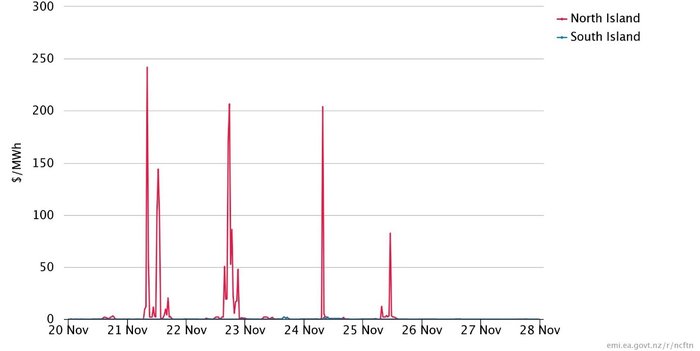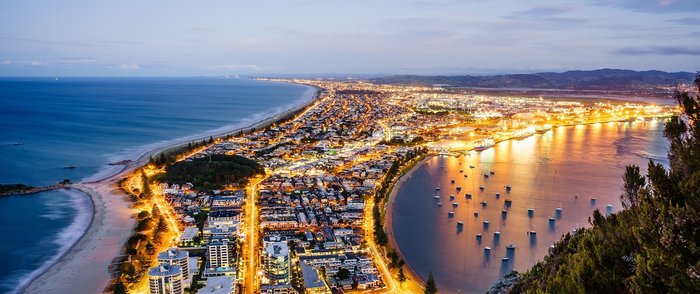Eye on electricity
Keeping the lights on with reserves
- Consumers
Why do we need electricity reserves?
Electricity is a unique product because electricity generation and consumption must match moment to moment. The System Operator sends instructions (based on an optimisation algorithm that minimises total system cost) to generators to ensure this balance is maintained, but there are always risks of unforeseen events. For example, a sudden change in electricity consumption, a transmission line getting damaged, or a generation unit failing. In order to ensure the lights stay on, there needs to be enough reserve ie, “just in case” generation capacity, to respond to an unexpected and sudden event.
The New Zealand power system runs on a frequency of 50 Hz. If electricity generation and consumption (including losses1) remain in balance, the frequency stays at 50 Hz. If consumption is higher than generation, the frequency will drop below 50 Hz and vice versa. The equipment on New Zealand’s grid is designed to operate in a relatively narrow band around 50 Hz and could be damaged or operate less efficiently if the frequency moves outside this band. Large thermal generating units are particularly sensitive and will disconnect from the grid to protect themselves from damage if they detect frequency outside the allowable band.
In the worst-case scenario, a drop in frequency could cause a generation unit to disconnect which could drop the frequency further, leading to a cascade of disconnections resulting in a black out. Frequency keeping reserve (FKR) and instantaneous reserve (IR) are designed to prevent such scenarios by responding to changes in frequency.
What is frequency keeping reserve?
To keep the frequency at 50 Hz, every half hour the System Operator selects one or more generators to be frequency keepers in each island. The frequency keepers monitor for small changes in frequency and adjust their generation output to keep the frequency within a small band around 50 Hz2. The HVDC also has controls to help balance the frequency between the islands, allowing the frequency keeping duty to be shared between generators in both islands. Frequency keeping is mainly intended to respond to small changes3 in electricity consumption or generation (such as sudden changes in wind generation), but is not enough to respond to a large change (such as a large generation unit suddenly failing), so instantaneous reserve is also needed.
What is instantaneous reserve?
Instantaneous reserve4 is spare capacity which can quickly respond in the event of an unexpected event which causes a large drop in frequency. This ensures the continued supply of electricity to consumers. The amount of instantaneous reserve needed is determined by the largest part of the system that could fail. This is usually either the largest generation unit that is running or the transfer across the HVDC.
Some instantaneous reserve is provided by interruptible load, for example hot water heating and some industrial processes. Interruptible load providers are paid the reserve price in exchange for allowing their load to be interrupted. However, the majority of reserves are provided by electricity generators. This is provided either by a unit generating below its full capacity5 or a unit ready to start generating within a few seconds6. Instantaneous reserve can be shared between the islands if the HVDC is not the largest risk and is not running at full capacity.
How does the reserve market impact the electricity market?
Electricity and reserves are produced by the same generation stations ie, a power station can offer in both electricity and reserves for the same time period7. However, any capacity used as electricity cannot be used as reserve and vice versa. The market selects the optimal allocation for each power station between what it should generate for electricity and what it should keep in reserve, to keep total system costs as low as possible.
Most of the time the cost of providing spare capacity as reserve is low. However, sometimes generators need to run units inefficiently to provide reserves, so this reserve is offered at a higher price. Other times generators would miss out on high electricity prices to provide reserve, so the reserve price is increased8 to make up the difference. Also, some units can only be used for reserves when they are generating already. This means that occasionally high-cost generation is brought on so that it can provide reserve9 as well. Again, the reserve price increases to account for this higher electricity cost. All these mechanisms can result in spikes in the reserve price, with a recent example shown in Figure 1. Most reserve prices were below $2/MWh during the week shown, with occasional spikes up to $250/MWh in the North Island.

The amount of reserve needed in each island is determined by the largest part of the system that could fail. This means that when reserve prices are high, reducing the size of this risk setter could reduce overall costs. For example, if the largest generator is 500 MW and running at full capacity, 500 MW of instantaneous reserve (IR) is needed to cover the risk. However, if the largest generator’s output is reduced to 490 MW, only 490 MW of IR is needed.
If the cost of an additional 10 MW of electricity from another generator is less than the cost of an extra 10 MW of IR, the largest generator will be asked to generate only 490 MW. This can also occur when the HVDC is the risk setter, constraining the amount of generation that can be transferred and contributing to price separation between the islands, discussed in ‘New Zealand’s geography and price separation’.
The Authority monitors both the spot energy market and reserve market in our weekly trading conduct reports.
The future of reserves
Battery technology offers new solutions to both frequency keeping and reserve, as well as other ancillary services like voltage support. Meridian Energy has recently received resource consent for its 100 MW battery storage project.
SolarZero, which offers solar panel and battery services, has started offering interruptible load into the reserve market, taking advantage of installed batteries. It is likely that battery technology will become an integral part of the reserve market (and the electricity market) and could reduce reserve prices.
1. For a description of losses, see our explainer: New Zealand’s geography and price separation.
2. The “normal” band is 49.8 to 50.2 Hz but often a tighter tolerance is achieved.
3. Up to around +/-30 MW.
4. There are two types of instantaneous reserve dispatched each trading period, fast instantaneous reserve (FIR), which must be able to react within 6 seconds and be sustained for 60 seconds, and sustained instantaneous reserve (SIR), which must be available within 60 seconds and be sustained for 15 minutes.
5. This is referred to as partly loaded spinning reserve (PLSR). Offers for PLSR take into account ramp up rate as well as total capacity. Most thermal and hydro generation units can offer PLSR, dependent on how quickly they can ramp up.
6. This is referred to as tail water depressed reserve (TWDR) and is offered by some hydro generation units. It involves running the unit like a motor without water flowing through the turbine. The control gates can be quickly opened to allow water to pass through the turbine and generate electricity if needed.
7. Interruptible load providers offer only into the reserve market.
8. The market clearing engine automatically increases the reserve clearing price to account for this lost opportunity (ie, opportunity cost) of generating electricity.
9. Partially loaded spinning reserve.
Related News
First compliance reports for retailers under Consumer Care Obligations due 30 September
The Electricity Authority is notifying electricity retailers that their 2024/25 compliance reports for the Consumer Care Obligations are now available to compl…
Electricity Authority appoints Daylight to deliver new comparison and switching service
The Electricity Authority has appointed innovative technology and creative studio Daylight to develop a new energy comparison and switching service.
Highlighting retailers’ obligations to protect medically dependent consumers
Under the Consumer Care Obligations retailers must not disconnect registered medically-dependent consumers, and must notify the Authority as soon as they becom…
